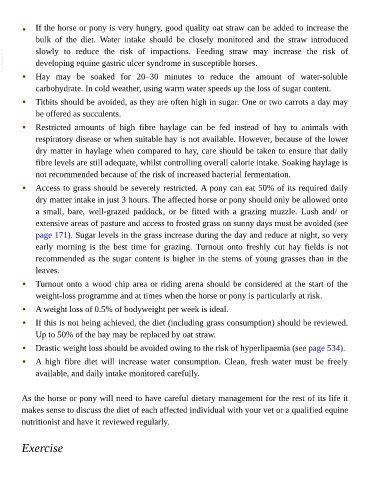Page 974 - The Veterinary Care of the Horse
P. 974
• If the horse or pony is very hungry, good quality oat straw can be added to increase the
bulk of the diet. Water intake should be closely monitored and the straw introduced
VetBooks.ir slowly to reduce the risk of impactions. Feeding straw may increase the risk of
developing equine gastric ulcer syndrome in susceptible horses.
• Hay may be soaked for 20–30 minutes to reduce the amount of water-soluble
carbohydrate. In cold weather, using warm water speeds up the loss of sugar content.
• Titbits should be avoided, as they are often high in sugar. One or two carrots a day may
be offered as succulents.
• Restricted amounts of high fibre haylage can be fed instead of hay to animals with
respiratory disease or when suitable hay is not available. However, because of the lower
dry matter in haylage when compared to hay, care should be taken to ensure that daily
fibre levels are still adequate, whilst controlling overall calorie intake. Soaking haylage is
not recommended because of the risk of increased bacterial fermentation.
• Access to grass should be severely restricted. A pony can eat 50% of its required daily
dry matter intake in just 3 hours. The affected horse or pony should only be allowed onto
a small, bare, well-grazed paddock, or be fitted with a grazing muzzle. Lush and/ or
extensive areas of pasture and access to frosted grass on sunny days must be avoided (see
page 171). Sugar levels in the grass increase during the day and reduce at night, so very
early morning is the best time for grazing. Turnout onto freshly cut hay fields is not
recommended as the sugar content is higher in the stems of young grasses than in the
leaves.
• Turnout onto a wood chip area or riding arena should be considered at the start of the
weight-loss programme and at times when the horse or pony is particularly at risk.
• A weight loss of 0.5% of bodyweight per week is ideal.
• If this is not being achieved, the diet (including grass consumption) should be reviewed.
Up to 50% of the hay may be replaced by oat straw.
• Drastic weight loss should be avoided owing to the risk of hyperlipaemia (see page 534).
• A high fibre diet will increase water consumption. Clean, fresh water must be freely
available, and daily intake monitored carefully.
As the horse or pony will need to have careful dietary management for the rest of its life it
makes sense to discuss the diet of each affected individual with your vet or a qualified equine
nutritionist and have it reviewed regularly.
Exercise

